![]()
![]()
![]()
Use LEFT and RIGHT arrow keys to navigate between flashcards;
Use UP and DOWN arrow keys to flip the card;
H to show hint;
A reads text to speech;
54 Cards in this Set
- Front
- Back
|
This is a longitudinal section of a peripheral nerve, shown are several nerve fibers, each fiber [1] is composed of a central axon surrounded by the wrapping of the Schwann cells. The junction where the Schwann cells meet is the node of Ranvier [2].
|

Identify the slide and what are 1 & 2?
|
|
|
This is a Peripheral Nerve, cross section. Shown is a cross section of several nerve fibers, axon [3] and nerve fiber [1].
|
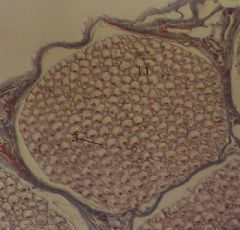
Identify the slide and what are 1 & 3?
|
|
|
This is a slide of the Nueromuscular Junction, Motor end plate [4], Muscular fibers [5], axon [6].
|
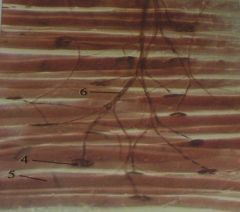
Identify the slide and what are 4, 5, & 6?
|
|
|
This is a slide of the Purkinji Cells that are found in the cerebellum, these cells relay information about posistion to the cerebrum. Punkinje cell [7], Dendrite [8].
|
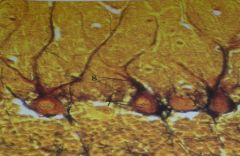
Identify the slide and what are 7 & 8?
|
|
|
This is a Motor Mueron, spinal cord smear slide. Axon [9], Dendrites [10], Nucleus of neuroglial cell [11].
|
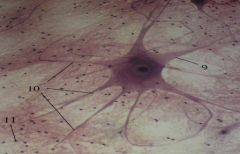
Identify the slide and what are 9, 10, 11?
|
|
|
This is Pyramidal Cells that are found in the cerebrum, these cells give control of muscle movements. Axon [9], Dendrite [10], Pyamidal cell body [12].
|
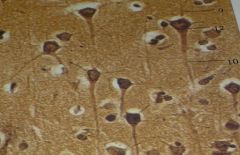
Identify the cells and there main function, and what are 9, 10, 12?
|
|
|
This is the Posterior Root Ganglion. Sensory neuron cell body [22], Nerve fibers [23].
|

Identify the cells and what are 22, 23?
|
|
|
This is a slide of the Spinal Cord's Posterior (Dorsal) and Anterior (Ventral); Gray matter [13], White matter [14], Central canal [15], Posterior gray horn [16], Anterior gray horn [17], Anterior root [18], Posterior root [19], Posterior root ganglion [20], Meninges [21].
|
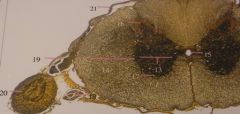
Identify the cells and what are 13, 14, 15, 16, 17, 18, 19, 20, 21?
|
|
|
This is a Spinal Cord (close up) slide. Gray matter [13], White matter [14], Motor nueron cell body [24]
|
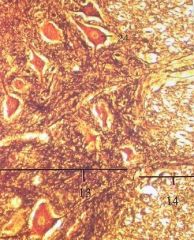
Identify the slide and what are cells, 13, 14, 24?
|
|
|
This is a slide of Smooth Muscle Tissue. Nucelus [1], Fiber [2].
|
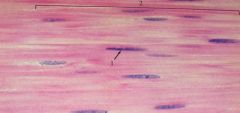
Identify the slide and what are the cells, 1, 2?
|
|
|
This is a Longitudinal section of Skeletal Muscle Tisue. Nucelus [1], Fiber [2].
|
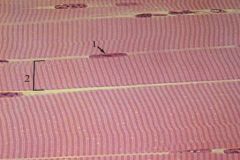
Identify the slide and what are cells, 1 & 2?
|
|
|
This is a cross section of Cardiac Muscle Tissue. Nuclus [1], Fiber [2].
|

Identify the slide and what are cells 1 & 2?
|
|
|
This is a Longitudinal section of Skeletal Muscle Tissue. Z-line [3], A-band [4], I-band [5].
|

Identify the slide and what are cells, 3, 4, 5?
|
|
|
This is a Longitudinal section of (fill in). Z-line [3], A-band [4], I-band [5].
|
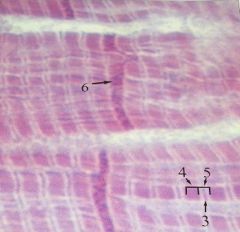
Identify the slide and what are cells, 3, 4, 5, 6?
|
|
|
This is Simple Squamous Epithelial Tissue. It is a single layer of flat with large central nuclei. This cell is found in alveoli, glamerular (Bowman's) capsule, lining of blood and lymphatic vessels, heart, and lining of ventral body cavity and viscera. Human mesothelium.
|
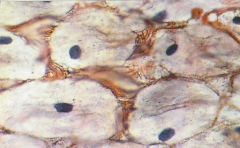
Identify the slide?
|
|
|
This is a section of Simple Squamous Epithelial Tissue, single layer of flat cells with large central nuclei. When seen in section they appear spindle-like. This is an Interior lining of blood vessel (endothelium).
|

Identify the slide and what are the cells?
|
|
|
This is a (Non-keratinized) Stratified Squamous Epithelial Tissue. The tissue is composed of several cell shapes. At the basal layer they are cuboidal or columnar, but are transformed to flattened squamous cells as they approach the surface. This tissue lines the wet surfaces of the mouth, esophagus, and vagina. This is a Human esopagus.
|
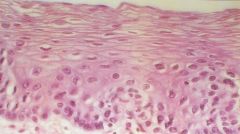
Identify the slide and what are the cells?
|
|
|
This is Stratified Cuboidal Epithelial Tissue. This tissue is usually composed of two layers of cuboidal cells. It is found in the ducts of sweat, salivary, and mammary glands. This is an Human sweat gland.
|
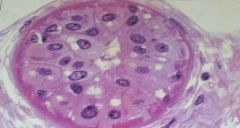
Identify the slide and what are the cells?
|
|
|
This is Glandular Epithelial Tissue (endocrine). This tissue produces and secretes hormones into the blood. Found in the thyroid, adrenals, pituitary, and isles of Langerhans etc. This is Human thyroid.
|
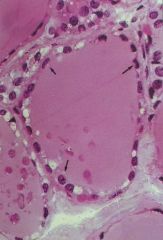
Identify the slide and what are cells?
|
|
|
This is Psuedostratified Epithelial Tissue. THis tissue appears stratified. but is actually a single layer of tall and short cells. All cells touch the basement membrane of hte tissue. This is Human trachea.
|
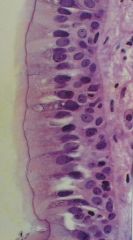
Identify the slide and what are the cells/tissues?
|
|
|
This is Glandular Epithelial Tissue (exocrine). This tissue sends its products through ducts into the digestive tract or to the outside of the body. Found in Brunner's gland, intestinal gland's, sweat glands, seminal vesicles, etc. This is Human intestinal gland.
|
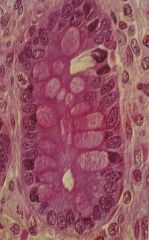
Identify the slide and what are the cells/tissues?
|
|
|
This is Stratified Columnar Epithelial Tissue. This tissue contains one of more layers of columnar cells and a basal layer of cuboidal cells. Found in few places (epiglonis, urethra, and some glands). This is Human epiglonis.
|
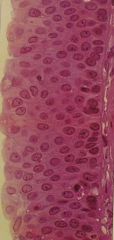
Identify the slide and what are the cells/tissues?
|
|
|
This is Simple Columnar Epithelial Tissue. Single layer of column-shaped cells. Basal nuclei are oval in cross section. Found in the digestive tract and excretory ducts of some glands. Ciliated columnar cells line the fallopian tubes, bronchi, and spinal cord. This is Human duodenum.
|
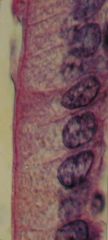
Identify the slide and what are the cells/tissues?
|
|
|
This is Transitional Epithelial Tissue. This tissue has the appearance of stratified squamous tissue except that the outer cells are rounded, which allows for stretching. Found in the lining of the urinary bladder and ureters. This is Urinary bladder.
|
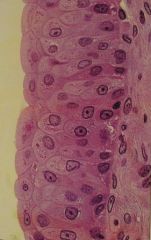
Identify the slide and what are the cells/tissues?
|
|
|
These are Erythrocytes, Blood Cells.
|

Identify the slide?
|
|
|
This is Neutrophils, Blood Cells.
|

Identify the slide?
|
|
|
These are Platelets, which are inbetween Blood Cells
|

Identify the slide?
|
|
|
This is Basophils, Blood Cells.
|

Identify the slide?
|
|
|
This is Leosinophils, Blood Cells.
|

Identify the slide?
|
|
|
These are Lymphocytes, Blood Cells.
|

Identify the slide?
|
|
|
These are Monocytes, Blood Cells.
|

Identify the slide?
|
|
|
This is Sponge Bone with the marrow removed.
|

Identify the slide?
|
|
|
This is Spongy Bone Section, trabelua [1], lacunae [3], open area is marrow
|
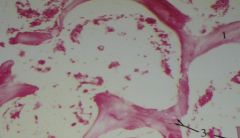
Identify the slide and the parts, also the open areas?
|
|
|
This is Osteocytes [top], they are located w/in the lacunae [left].
|
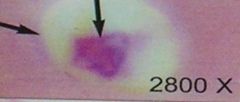
Identify the slide and the arrows, left & top?
|
|
|
This is Single Osteon (Haversian System) Bone Tissue. Haversian canal [5], lacuna [7], canaliculi [8].
|
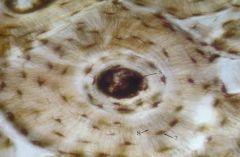
Identify the slide and 5, 7, 8?
|
|
|
This is Low Magnified Compact Bone Tissue. Osteon [4], Haversian canal [5], Volkmann canal [6].
|
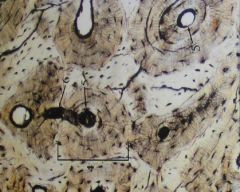
Identify the slide and 4, 5, 6?
|
|
|
This is pandorina and...?
|
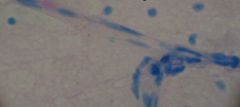
Identify the slide?
|
|
|
This is Simple Cuboidal Epithelial Tissue. Single layer of cube-shaped cells w/central spherical nuclei. Found in kidney tubules, ducts of glands, and surface ovary. This is Kidnet tubule.
|

Identify the slide and the cells/tissues?
|
|
|
This is Simple Columnar Epithelial Tissue. Single layer of column-shaped cells. Basal nuclei are oval in cross section. Found in the digestive tract and excretory ducts of some glands. Ciliated columnar cells line the fallopian tubes, bronchi, and spinal cord. This is Human duodenum.
|
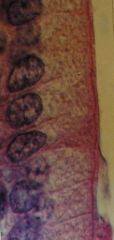
Identify the slide and the cells/tissues?
|
|
|
This is Stratified Squamous Epithelial Tissue. This tissue is composed of several cell shapes. At the basal layer they are cuboidal of columnar, but are transformed so flattened squamous cells as they approach the surface. The tissue forms the epidermis of skin. This is Human skin.
|
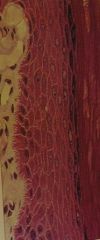
Identify the slide and the cells/tissues?
|
|
|
This is an Amoeba, it has food vacuoles, endoplasm, nucleus, cell membrane, psuedopodia, contractile vacuole, ectoplasm.
|
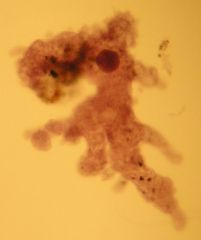
Identify the slide and all of the parts?
|
|
|
This is a Sarcodines that has psuedopodia.
|
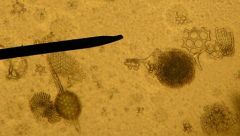
Identify the slide?
|
|
|
This is Volvox, which has little vegetative cells (small dots covering cell), daughter colonies (full size circles inside cell), the space in between the vegetative cells is the cytoplasmic connection (between cells).
|
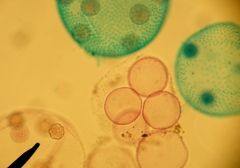
Identify the slide?
|
|
|
This is Volvox, it has vegetative cells covering the entire surface, cytoplasmic connection between cells, daughter colonies (smaller ones are immmature daughter cells)
|
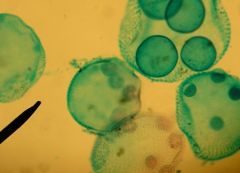
Identify the slide?
|
|
|
This is Stratified Squamous Epithilium Tissue of Frog skin (whole mount).
|

Identify the slide and the particular cell names?
|
|
|
This is Cuboidal Epithelium Tissue of a kidney.
|

Identify the slide?
|
|
|
This is Simple Columnar Epithelium Tissue, frog small intestine.
|
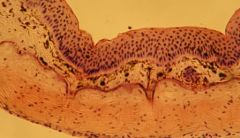
Identify the slide?
|
|
|
This is Loose Connective Tissue, which has fibroblasts and macrophages.
|

Identify the slide?
|
|
|
This is Dense Fibrous Connective Tissue, which has fiber bundles, nuclei of fibroblasts that are squeezed between the bundles.
|

Identify the slide?
|
|
|
This is Adipose Connective Tissue, which possesses a lot of "extracytoplasmic" material produced by its cells. These are tightly packed cells, adipocytes that store large amounts of triglycerides within intracellular FAT VACUOLES.
|
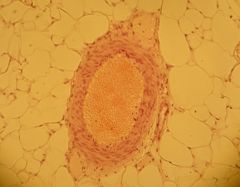
Identify the slide?
|
|
|
This is Cartilage Connective Tissue. It consists of cells, chondrocytes, which occupy small cavities of space called lacunae and they sectrete a dense gelatious substance called chondrin as well as collagenous fibers cells
|
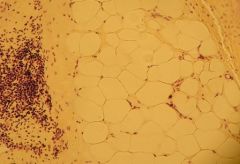
Identify the slide?
|
|
|
This is Cartilage Connective Tissue, it is filled with randomly arranged collagenous fibers.
|
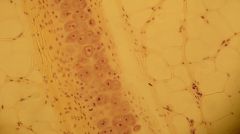
Identify the slide?
|
|
|
This is Bone Connective Tissue. The cells of bone are called Osteocytes, which lay down the bony matrix called the Haversian system, where the secretion of concentrated layers is done in the lamellae, which surround a canal called the Haversian canal, this location houses blood vessels and nerves that supply the bone. So, one Haversian canal with its surrounding lamellae and lacunae are called an Osteon.
|
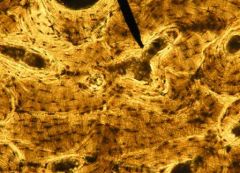
Identify the slide?
|
|
|
This is Blood a Connective Tissue. They are (red blood cells) Eurythrocytes, which are specialized in carrying oxygen, and white blood cells, Leucocytes, which make up the bodies defense system against foreign organisms and particles. Both cells are widely placed in a matrix called the PLASMA. The PLASMA contains a liquid ground substance called SERUM.
|
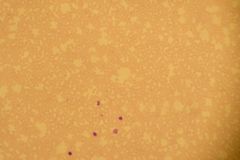
Identify the slide?
|

